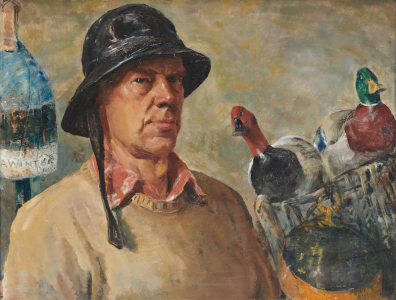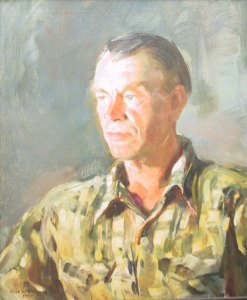

Biography
By all accounts, Andrew Winter was a rugged individual. Born in Sindi, Estonia in 1892, he went to sea at age 21 to fund an education in the arts. First working on square riggers, he served as a mate on British and American ships in World War I. He became an American citizen in 1921 and finally was able to study art - at the National Academy of Design in New York. He received a traveling fellowship in 1925 that took him to Paris and Rome and later spent time at the Cape Cod School of Art in Provincetown, MA and the Louis C. Tiffany Foundation in Oyster Bay, NY.
But the strongest influence on Winter's art came when he began to visit Monhegan Island, ME in the late 1920s. He fished with the local lobstermen and eventually settled full-time on the Island, rowing around the island even in foul weather to capture images of the seas pounding against the cliffs. He retained ties with urban galleries, and his paintings were a success. A Philadelphia newspaper gave an evocative description of Winter in 1937: "Winter's arms, heavily tattooed with mermaids, geisha girls, dragons, sea-horses, tropical birds and bathing beauties of all climes and races, have not interfered with his strenuous rise to artistic fame"
Winter received a commission for the Wolfeboro, NH Post Office mural in 1940, and in 1937 his painting "Wreck at Lobster Cove" won Edwin Palmer Memorial Prize for best marine painting at the National Academy of Design. Winter died in Brookline, MA in 1958, with his ashes scattered in the seas around Monhegan Island.


Critical Analysis
Monhegan Island has been a popular summer venue for artists since the 19th century. But it was unusual for any artist to want to stay on into the harsh winter. Andrew Winter, aptly named as it turned out, relished this kind of weather and the crashing of heavy seas onto snow-flecked rocks. He would take notes for his pictures as he rowed a small skiff around the working lobstermen. And he successfully captured the strength and beauty of these scenes in his paintings.
Most of Winter's work focused on the sea, and most of it depicted water and rocks, with very few people. This concentration - and the skill of his depiction of maritime scenes - gives his art an unusual sort of purity. A viewer is readily struck by the energy of the wind and waves. While this energy is accurately conveyed by the quality of Winter's representation, the focus is always on his eternal subject, the sea, with his artful brushwork and subtle use of color underscoring the work rather than taking precedence themselves. Winter is one of the relatively few Depression Era artists whose work remains in significant demand, with examples fetching prices as high as the tens of thousands of dollars.
Murals
- Wolfeboro, New Hampshire - Post Office: New Hampshire Sugar Camp
References
- Andrew Winter (Wikipedia).
- Andrew Winter (Mark Murray Fine Paintings).
- Andrew Winter (Art in Embassies).
- Andrew Winter, Monhegan, World Famous Artist, Dies, Evening Express October 27 (1958).
- Bob Keyes, Andrew Winter's paintings of Monhegan in the off-season, Portland Press Herald July 23 (2017).
- Jerry Weiss, The Seclusion of Winter, Linea July 23 (2017).